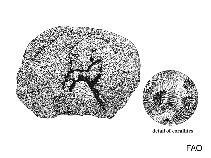Manicina areolata (Linnaeus, 1758)
Rose coral| Native range | All suitable habitat | Point map | Year 2050 |

|
| This map was computer-generated and has not yet been reviewed. |
| Manicina areolata AquaMaps Data sources: GBIF OBIS |
Upload your photos
Google image | No image available for this species;
drawing shows typical species in Faviidae.
Google image | No image available for this species;
drawing shows typical species in Faviidae.
Classification / Names Common names | Synonyms | CoL | ITIS | WoRMS
Anthozoa | Scleractinia | Faviidae
Environment: milieu / climate zone / depth range / distribution range Ecology
Reef-associated; depth range 0 - 65 m (Ref. 848). Tropical; 33°N - 8°N, 92°W - 58°W (Ref. 848)
Distribution Countries | FAO areas | Ecosystems | Occurrences | Introductions
Western Atlantic: Gulf of Mexico, Caribbean to Bermuda.
Length at first maturity / Size / Weight / Age
Maturity: Lm ? range ? - ? cm
Short description Morphology
Colony: either free-living with cone-shaped undersurface, or attached. Small colonies: oval shaped, with a central axial valley with short side valleys. Larger colonies: hemispherical, meandroid. With distinct ambulacral groove along the tops of valley walls (Ref. 848).
Maximum depth from Ref. 83917. Zooxanthellate (Ref. 116012). Small and free-living colonies in subtidal seagrass beds; attached and hemispherical in shallow reef environments (Ref. 848). Also common in sand and coral rubble (Ref. 415)
Life cycle and mating behavior Maturity | Reproduction | Spawning | Eggs | Fecundity | Larvae
Hermaphroditic (Ref. 113712). Mature gametes are shed into the coelenteron and spawned through the mouth. Life cycle: The zygote develops into a planktonic planula larva. Metamorphosis begins with early morphogenesis of tentacles, septa and pharynx before larval settlement on the aboral end (Ref. 833).
Main reference
References | Coordinator | Collaborators
Collin, R., M.C. Díaz, J. Norenburg, R.M. Rocha, J.A. Sánchez, M. Schulze, A. Schwartz and A. Valdés. 2005. (Ref. 415)
IUCN Red List Status (Ref. 130435)
Least Concern (LC) ; Date assessed: 01 June 2021
CITES status (Ref. 108899)
Appendix II: International trade monitored
CMS (Ref. 116361)
Not Evaluated
Threat to humans
Human uses
| FishSource |
Tools
More information
Internet sources
BHL | BOLD Systems | CISTI | DiscoverLife | FAO(Publication : search) | Fishipedia | GenBank (genome, nucleotide) | GloBI | Gomexsi | Google Books | Google Scholar | Google | PubMed | Hexacorallians of the World | Tree of Life | Wikipedia (Go, Search) | Zoological Record
Estimates based on models
Preferred temperature
(Ref. 115969): 24.9 - 28.1, mean 27 (based on 188 cells).
Price category
(Ref. 80766):
Unknown.



